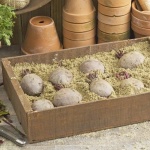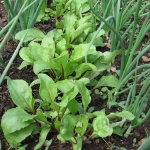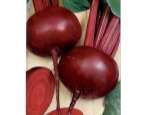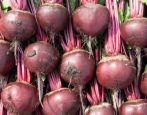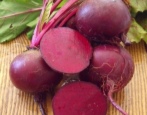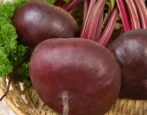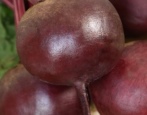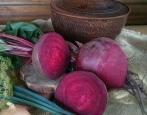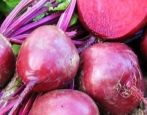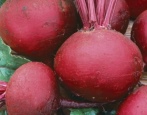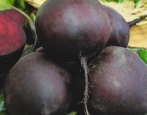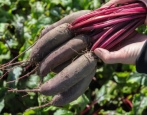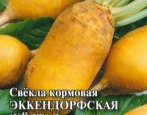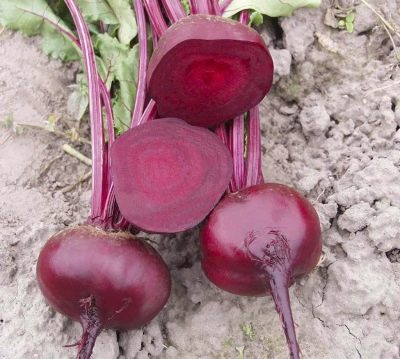
- Year of approval: 2006
- Leaf rosette shape: upright
- Leaves: oval, green, slightly bubbly, low to medium waviness
- Petiole: bottom side red
- The form: rounded
- Weight, g: 280-420
- Cork head: the average
- Pulp color : red
- Ringiness: no ringing
- Taste qualities: good and excellent
Wodan beetroot is one of the healthiest hybrid varieties that is used to prepare a variety of culinary masterpieces. The culture is distinguished by its high yield and juicy pulp, for which it is appreciated by gardeners.
Description of the variety
Beet Wodan belongs to a group of plants with an early ripening period. Among the main characteristics of culture are:
powerful rosette of leaves;
dark green color of leaf plates;
lack of rings in the root crop.
The variety is suitable for growing in open fields with proper preparation of seeds and soil for planting.
Characteristics of the appearance of the plant and root crops
Wodan beet is considered one of the most attractive hybrids, which pleases gardeners with high yields. Root characteristics:
shape - rounded;
weight - from 280 to 420 g;
the skin is thin, dark purple;
the pulp is red and juicy.
The composition of beets contains up to 15.2% of dry matter, as well as 11.9% of sugar.
Purpose and taste of tubers
The tasters managed to evaluate the taste characteristics of the root vegetables, noting the rich and very juicy taste. Wodan beets are suitable for fresh consumption, as well as for preparing various dishes or salads. Excellent keeping quality guarantees a long shelf life without loss of taste.
Maturation
On average, Wodan beets take 80 days to form large and juicy tubers. If desired, the ripening time can be reduced if you take care of the plant's care.
Yield
The yield indicator averages 280-480 centners per hectare. This is one of the highest rates, which makes beets in demand among large agricultural enterprises.
Growing and care
The variety is grown mainly by seed. For this, preliminary preparation of the seed and soil is carried out, in which it is planned to plant the seeds. Stages of preparation.
Selection. Beet seeds are carefully inspected for deformities, affected areas. Preference is given to whole and healthy seeds.
Disinfection. It is carried out by soaking the seeds in a solution of potassium permanganate. Weakly concentrated formulations are usually used.
Treatment. The seeds are additionally sprayed with growth stimulants in order to improve the survival rate of seedlings and accelerate their development.
At the same time, soil preparation is carried out, which includes the application of fertilizers that neutralize the acidity or alkalinity of the soil, as well as loosening for an even distribution of nutrients.
Seed planting is carried out according to the following scheme.
Up to 30 cm recede between the rows.
A distance of 10 cm is maintained between the seeds.
The maximum depth at which the seeds can be planted should not exceed 5 cm.
When planting work is completed, it remains to take care of the care of the plant. Agrotechnical recommendations.
Watering. Beets do not need to be watered too often.It is only important to monitor so that the soil does not dry out, otherwise it will negatively affect the juiciness and taste of the tubers. On average, beets are watered 1-2 times a week, reducing the amount of liquid applied during rains and increasing during dry weather.
Loosening. It is carried out after each watering in order to saturate the soil with oxygen and useful components. And also loosening accelerates the flow of nutrients to the roots of the plant.
Top dressing. Usually beets are fed 3-4 times per season. Particular attention is paid to the growing season and root crop development. It is customary to use mineral complexes as fertilizers, which contain potassium and phosphorus.
Additionally, it is worthwhile to provide for weeding the beds, which will prevent the spread of diseases and pests to the tops and tubers of beets.

Beetroot tolerates cold snaps, therefore it is widely grown in the open field. When planting beets, you need to correctly determine the sowing time, choose a suitable place, prepare the beds, and do pre-sowing seed treatment.
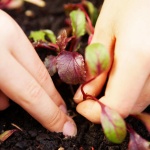
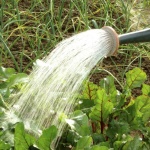
Soil requirements
Wodan beets are grown in fertile soils. Among the recommendations for choosing a landing site:
the site must be sunny and calm;
groundwater must run deep;
the acidity index should be neutral.
Preference should be given to sandy loams or sandstones; in heavy soils, beets will be harder to grow.
Required climatic conditions
Disembarkation is best done in warm and sunny weather. It is important to wait until the soil warms up to a temperature of at least +8 degrees Celsius, and the risk of frost return will be minimal. Otherwise, the seedlings will quickly die, and the harvest will be scarce.
Disease and pest resistance
Wodan is one of the most resistant to most diseases and pests of hybrids, which rarely gets sick and forms a large crop. However, with too frequent watering, non-compliance with agrotechnical recommendations for caring for the plant, in principle, there is a high probability that the culture will get sick or be attacked by insects.
Preventive treatments can help prevent the risk of beetroot disease. To do this, use a solution of potassium permanganate when disinfecting seeds or other compounds of low concentration. Before using drugs, you should carefully study the instructions.

